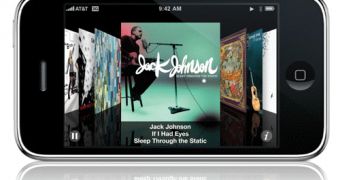Apple's iPhone 3G, officially announced only two days ago, on June 9, will almost surely be one of the most popular mobile devices of this year and probably next year too. I'm saying this because the handset offers even more than what the first-generation iPhone does and we all know that the latter is a huge commercial success.
Coming with the slogan "Twice as fast, half the price", the iPhone 3G is, indeed, a lot faster than the previous iPhone when it comes to data transfer speeds and Web browsing. That's thanks to the tri-band 3G / HSDPA connectivity, of course (which, according to many, should have been included in the iPhone from the beginning).
Aside from 3G, the new iPhone also brings internal GPS, A-GPS, App Store access, support for Microsoft Exchange, a longer battery lifetime and an overall improved design. Added to the features already existent in the first iPhone, the new ones make iPhone 3G worthy to be called king (of all mobile devices, if you will).
But before you hurry up and bestow this kind of title on iPhone 3G, you should also know about the aspects that pretty much make the handset a beggar and not a king.
1. The "MMS curse" that was present with the first iPhone has stuck to the iPhone 3G too. Therefore, the iPhone 3G is, like the first-generation handset, not capable of sending and receiving MMS. I'm no MMS specialist (if I may say so myself), but how hard can it be to make a mobile device capable of sending and receiving these types of messages? The vast majority of phones currently on the market can do that. So why is it that the iPhone 3G can't do it?
2. The photo camera integrated in the iPhone 3G is the old one from the previous model. This means 2 Megapixels with no auto focus, no flash and, most notable, no video recording. Now, even entry-level phones from manufacturers like Nokia, Sony Ericsson or Samsung can have better photo cameras. Furthermore, while lots of the mid and high-end handsets that feature 3G connectivity have a secondary camera for video-calls, the iPhone 3G, like the first iPhone, does not have one.
3. Although iPhone 3G comes with Bluetooth 2.0, this does not support A2DP (Advanced Audio Distribution Profile). Bluetooth 2.0 with A2DP is a common feature to all the multimedia-oriented handsets and, without it, iPhone 3G is an incomplete multimedia device.
4. Last of all, the new iPhone has no memory expansion slot. Sure, when you have 8 or 16 GB of memory on board, chances are that you don't even need a memory card slot. But wouldn't it have been nice if iPhone 3G had offered the memory expansion feature, like Samsung Omnia, for example, which (coincidence or not) was also announced on June 9? I believe it would.
Sure, the above mentioned flaws of iPhone 3G can be ignored by lots of users who will love the handset for its wide 3.5 inch display, its Mac OS X interface and all the other cool things that it offers. But that doesn't change the fact that, from some (important) points of view, the iPhone 3G is inferior to many mobile devices released this year.
Anyway. Available on most of the global markets by the end of 2008 (click here to see the exact countries and carriers), iPhone 3G is set to take the mobile world by a storm far greater than the one the first iPhone had started.
Just in case you haven't seen the iPhone 3G commercial yet, although it's highly unlikely, we're posting it below. Listen how Robert Downey Jr. (yes, that's him speaking) says about the 3G handset that it's "the first phone to beat the iPhone". As if it's something really out of the ordinary for a new-generation device to "beat" an old-generation one.

 14 DAY TRIAL //
14 DAY TRIAL //